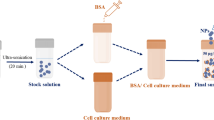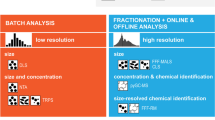Abstract
Increased use of nanomaterials in everyday products leads to their environmental release and therefore, the information need on their fate and behaviour. Nanomaterials have to be suspended with high repeatability and comparability for studies on environmental effects. They also have to be well characterised with a focus on the state of agglomeration and particle size distribution. Dynamic light-scattering (DLS) is a common technique used for these measurements. If suspensions are prepared in different laboratories, then concern has risen about the comparability of the measured results, especially when different DLS instruments are used. Therefore, for quality assurance, a round-robin test was conducted to assess the comparability of different DLS instruments and a dispersion protocol in ten independent laboratories. Polystyrene and TiO2 were chosen as test (nano)materials. For the comparability of the DLS instruments, the average sizes of the PSL and a stabilised TiO2 suspension were measured. The measured average hydrodynamic diameter shows an overall good inter-laboratory comparability. For the PSL suspension, an average hydrodynamic diameter of 201 ± 13 nm and for the TiO2 suspension an average diameter of 224 ± 24 nm were detected. For the TiO2 suspension that was prepared at each laboratory following an established suspension preparation protocol, an average hydrodynamic diameter of 211 ± 11 nm was detected. The measured average particle size (mode) increased up to 284 nm with a high standard deviation of 119 nm if the preparation protocol could not established and different procedures or different equipment were employed. This study shows that no significant differences between the employed DLS instrument types were determined. It was also shown that comparable measurements and suspension preparation could be achieved if well-defined suspension preparation protocols and comparable equipment can be used.





Similar content being viewed by others
Notes
Some laboratories had only a different or no ultrasonic probe. In those cases, the other probe or an ultrasonic bath was used.
References
Benn TM, Westerhoff P (2008) Nanoparticle silver released into water from commercially available sock fabrics. Environ Sci Tech 42:4133–4139
Berber S, Tomanek D (2009) Hydrogen-induced disintegration of fullerenes and nanotubes. An ab initio study. Phys Rev B 80(7):75421–75425
Chen G, Liu X, Su C (2012) Distinct effects of humic acid on transport and retention of TiO2 rutile nanoparticles in saturated sand columns. Environ Sci Tech 46:7142–7150
Cornelis G, Hund-Rinke K, Kuhlbusch T, Van den Brink N, Nickel C (2014) Fate and bio-availability on engineered nanoparticles in soils: a review, Crit Rev Environ Sci Technol, in press
Gartiser S, Nickel C, Stintz M, Damme S, Schaeffer A, Erdinger L, Kuhlbusch TAJ (2014) Behaviour of nanoscale titanium dioxide in laboratory wastewater treatment plants according to OECD 303 A, Chemosphere, in press
Gasser M, Wick P, Clift MJD, Blank F, Diener L, Yan B, Gehr P, Krug HF, Rothen-Rutishauser B (2012) Pulmonary surfactant coating of multi-walled carbon nanotubes (MWCNTs) influences their oxidative and pro-inflammatory potential in vitro. Part Fibre Toxicol 9:17
Gottschalk F, Sonderer T, Scholz RW, Nowack B (2009) Modeled environmental concentrations of engineered nanomaterials (TiO2, ZnO, Ag, CNT, Fullerenes) for different regions. Environ Sci Tech 43(24):9216–9222
Hassellöv M, Readman J, Ranville J, Tiede K (2008) Nanoparticle analysis and characterization methodology in environmental risk assessment of engineered nanoparticles. Ecotoxicology 17:344–361
Hsu LJ, Chein HM (2007) Evaluation of nanoparticle emission for TiO2 nanopowder coating materials. J Nanopart Res 9:157–163
Huang YY, Knowles TPJ, Trentjev EM (2009) Stregth of nanotubes, filaments, and nanowires from sonication-induced scission. Adv Mater 21(38–39):3945–3948
Kaegi R, Ulrich A, Sinnet B, Vonbank R, Wichser A, Zuleeg S, Simmler H, Brunner S, Vonmont H, Burkhardt M, Boller M (2008) Synthetic TiO2 nanoparticle emission from exterior facades into the aquatic environment. Environ Poll 156:233–239
Kaegi R, Sinnet B, Zuleeg S, Hagendirfer H, Mueller A, Vonbanj R, Boller M, Burkhardt M (2010) Release of silver nanoparticles from outdoor facades. Environ Poll 158:2900–2905
Kaszuba M, McKnight D, Connah MT, McNeil-Watson FK, Nobbmann U (2008) Measuring sub nanometre sizes using dynamic light scattering. J Nanopart Res 10:823–829
Kim H-J, Phenrat T, Tilton RD, Lowry GV (2012) Effect of kaolinite, silica fines and pH on transport of polymer-modified zero valent iron nano-particles in heterogeneous porous media. J Colloid Interface Sci 370:1–10
Koppel DE (1972) Analysis of macromolecular polydispersity in intensity correlation spectroscopy: the method of cumulants. J Chem Phys 57(11):4814–4820
Kuhlbusch TAK, Nickel C, Hellack B, Gartiser S, Flach F, Schiwy A, Maes H, Schaeffer A, Erdinger L, Gabsch S, Stintz M (2012) Fate and behaviour of TiO2 nanomaterials in the environment, influenced by their shape, size and surface area, UBA Final Report 25/2012, Environmental Protection Agency, Germany, pp. 163. http://www.umweltdaten.de/publikationen/fpdf-l/4301.pdf
Provencher SW (1982) CONTIN. A general purpose constrained regularization program for inverting noisy linear algebraic and integral equations. Comput Phys Commun 27:229–242
Roebben G, Ramirez-Garcia S, Hackley VA, Riesslein M, Klaessig F, Kestens V, Lynch I, Garner CM, Rawle A, Elder A, Colvin VL, Kreyling W, Krug HF, Lewicka ZA, McNeil S, Nel A, Patri A, Wick P, Wiesner M, Xia T, Oberdörster G, Dawson KA (2011) An interlaboratory comparison of size and surface charge measurements on nanoparticles prior to biological impact assessment. J Nanopart Res 13:2675–2687
Taurozzi JS, Hackley VA, Wiesner MR (2011) Ultrasonic dispersion of Nanoparticles for environmental, health and safety assessment—issues and recommendations. Nanotoxicology 5(4):711–729
von der Kammer F, Ottofuelling S, Hofmann T (2010) Assessment of the physico-chemical behavior of titanium dioxide nanoparticles in aquatic environments using multi-dimensional parameter testing. Environ Pollut 158:3472–3481
Wang R, Hughes T, Beck S, Vakil S, Li S, Pantano P, Draper RK (2013) Generation of toxic degradation products by sonication of Pluronic® dispersants: implications for nanotoxicity testing. Nanotoxicology 7:1272–1281
Wise J, Wise JP Sr (2011) A review of the toxicity of chemical dispersants. Rev Environ Health 26(4):281–300
Xu R (2000) Particle characterization: light scattering methods. Particle technology series. Kluwer Academic Publishers, London
Acknowledgment:
The Round Robin Test was conducted during the study by Kuhlbusch et al. (2012) which was funded by the federal environment agency within the framework of the UFOPLAN 2009 of the Federal Ministry for the environment, nature conservation and nuclear safety. The authors thank the Institute TMC at the University of Hamburg for providing the Malvern Zetasizer for the measurements and Michael Gröger for his support in the lab.
Author information
Authors and Affiliations
Corresponding author
Rights and permissions
About this article
Cite this article
Nickel, C., Angelstorf, J., Bienert, R. et al. Dynamic light-scattering measurement comparability of nanomaterial suspensions. J Nanopart Res 16, 2260 (2014). https://doi.org/10.1007/s11051-014-2260-2
Received:
Accepted:
Published:
DOI: https://doi.org/10.1007/s11051-014-2260-2




